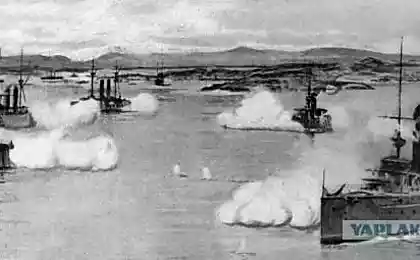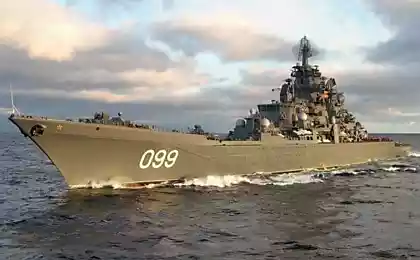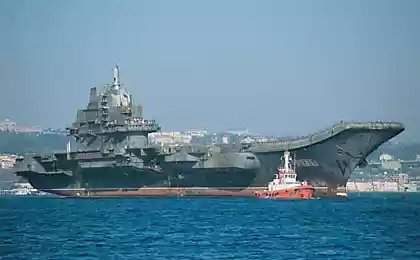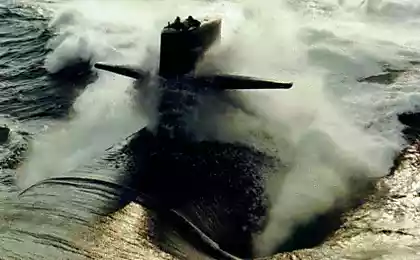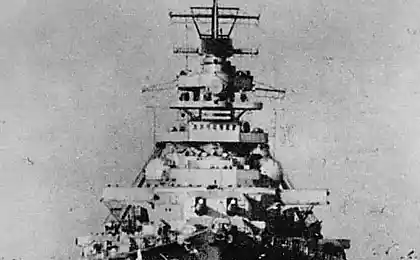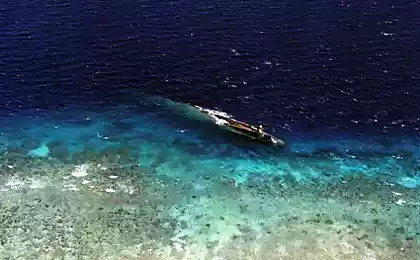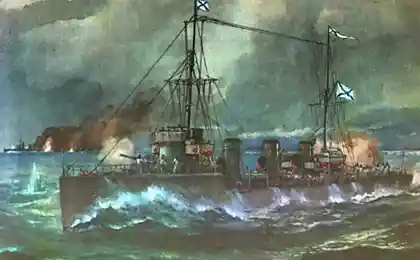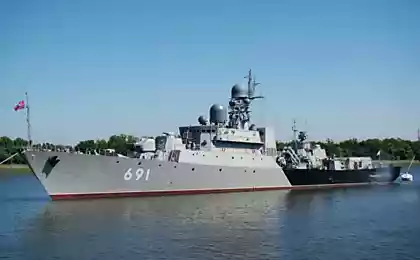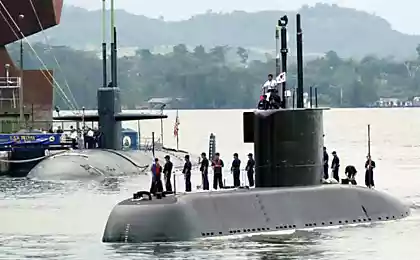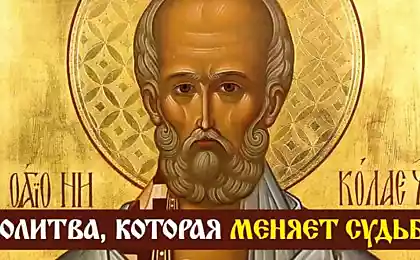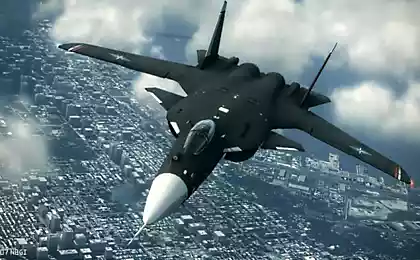779
Missile cruiser "Peter the Great"
Missile cruiser "Peter the Great" is great not only in size, but combat capabilities. We have learned how to overcome any missile defense missiles in what the vulnerability of NATO ships, the American air defense system equipped with "Aegis", and why it is impossible to sink the cruiser itself.
The flagship of the Northern Fleet, the largest in the world aircraft carriers, heavy nuclear missile cruiser "Peter the Great" is really great - both in size and combat capabilities. His main weapon - cruise missiles "Granit" - are able to overcome any missile defense system and destroy the target, regardless of its size and the degree of protection. Missiles on board the cruiser 300, enough for many purposes. The main task of the ship is hunting for enemy aircraft carriers and their entourage.
Layered air defense cruiser reliably covers all of its existing and future assets of the air of defeat. No less serious and anti-submarine defense, consisting of helicopters and sonar, supersonic missiles, torpedoes and ingenious protivotorped, jet mortars and multiple rocket launchers. On the artillery duel in the modern sea battle speech does not go, so the main battery in the cruiser presented several towers with twin 130-mm guns. It is rather a tribute to the tradition - that of a cruiser without guns. "Granite" against "Aegis»
In 1983 came into operation the American missile cruiser "Ticonderoga". The ship was decorated with a banner "Beware, Admiral Gorshkov! "Aegis" in the sea! "Cruiser became the first American ship, equipped with combat information control system" Aegis "(Aegis). It brings together in a single network radar ships that are running, providing tracking of hundreds of surface, underwater and air targets, their automatic selection and guidance of weapons nearby ships to the most dangerous objects. Edakii Naval Internet.
In Greek mythology, Aegis shield called Zeus, made of the skins of magic goat Amalthea. In the middle of the shield was assigned the head of Medusa the Gorgon, gaze turns a man into stone. Now CICS "Aegis" equipped with 107 vehicles five countries. The heart of the system is a universal radar AN / SPY-1 - Four huge phased array antenna is mounted on its superstructures each armed "Aegis" ship. "Spy" is able to automatically search, classify and track targets, putting them anti-aircraft missiles. The use of a single multi-function radar allows us to simplify the collection and analysis of information, as well as eliminate the interference arising from the large number of radar.
However, in the universality of the radar "Aegis" lies their Achilles heel. One of the biggest challenges - how to effectively teach the radar to detect targets at large and small distances simultaneously. The creators hoped to "Interactive" system architecture: that the radar will detect distant targets and transmit information about them ship that close, and those are the targets to shoot down. But for this it is necessary to uniformly disperse the ships "Aegis" in the ocean, which in reality is impossible. In the context of the closeness of the battle order - order aircraft carrier, for example, - architecture is not working.
The main problem of "Aegis" - its radars operate in the decimeter range. Radio waves of such length is well reflected from the waves of the sea, so above the water noise and chaos system is blind to the ultra-low altitudes. Namely, they fly to the goal of the modern anti-ship cruise missiles - such as "Granite", the main weapon of "Peter the Great».
Vulnerability "Aegis" proved incident on 24 February 1991, in the Persian Gulf. In the US battleship "Missouri" grinds Iraqi forces 406-mm shells of the main fire, the shore launched two anti-ship missiles "Haiying 2" (a copy of the Soviet RCC "Termite" extended range). "Aegis" slept through the attack successfully. One rocket is 600 meters from the side of the British battleship destroyer shot down "Gloucester" - this was the first ever case of successful intercept anti-ship missile in combat using anti-aircraft missile system of short-range. The second "Missouri" led by himself, firing radar traps. According to another version, the missile fell into the water itself.

Fire sword
"Granite" at this chaff not up to snuff. When you create a set for the first time anti-ship sank with three channels targeting: mother ship, the missile itself and the external devices - they could be satellites, aircraft and other missiles. RCC "Granite" is equipped with an onboard computer trehprotsessornym (FDC). In his memory incorporated data on modern ship classes and types of orders, allowing the missile to determine that before her: the convoy, aircraft carrier or amphibious group - and attack the main goal in the group. This onboard computer analyzes used by the adversary electronic warfare, rebuilt from interference and issues commands to evade fire air defense systems.
Containers with the "granite" located under the main deck of "Peter the Great" with a slope of 60 degrees. Before starting the rocket container filled with seawater to hellfire solid booster not hurt silos. Through the accelerator the most noticeable part of the trajectory starting overcome a couple of seconds. Then turn on marching turbojet engine, the rocket rise to a height of 10-14 kilometers and "inspected". Finding purpose, "Granite" is reduced to 25 meters off the homing head and flies at half-two thousand kilometers per hour. GOS is activated just before the attack.
A group of attacking missiles. The main part of it invisible to radar sweeps over the water, one is flying high, diverting the enemy's air defense and coordinating action remaining. If her astray, takes place next leader. When an external target designator - aircraft or satellites - missiles and all can get to the goal secretly. The onboard computer incorporated several options for types of trajectories for each theater of operations and the type of target.
Arriving in the area of the attack, "Granite" include homing, for a split second partitioned between a target and hit them. To destroy surface ships used penetrating warhead with 750 kilograms of powerful explosives. Submarines stoked nuclear warhead capacity of 500 kilotons - such an explosion on the surface enough to destroy any submersible at a depth of up to a kilometer.
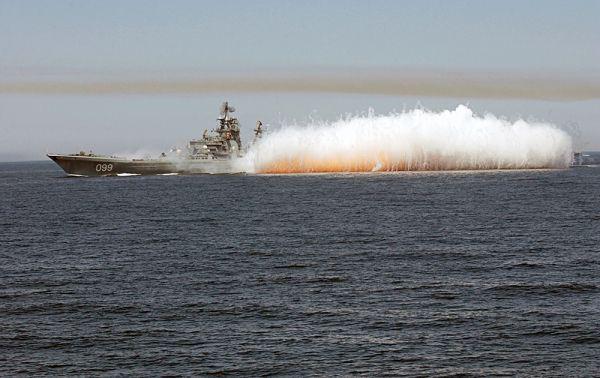
Reactive Shield
The air defense cruiser "Peter the Great" was organized at several levels. Long approaches gated complex "Fort", a naval version of the proven S-300 systems. Below deck are 12 launchers with a total of 96 rockets ammunition. Multifunction radar can simultaneously track 12 targets, firing six most dangerous. For the moment the system can make 20 starts.
If the rocket had managed to bypass the enemy: "Fort", it will meet the complex "Dagger", designed to reflect the massive flying air targets. His launchers and hidden under the deck. 16 plants, they drum, each containing eight missiles. "Dagger" affects low-flying targets at a height of 10 meters and at a distance of 45 kilometers. Radar complex accompanied by eight goals, while four of them firing. From the detection of the target before the start goes eight seconds. Antiaircraft missile warhead high explosive. By radio before it explodes purpose, forming a cloud of fire and metal. An enemy shell flies into him, his speed exacerbating the damage.
Antiaircraft artillery complex short-range "Dirk" protected cruiser of high-precision weapons, planes, helicopters and boats, each of the six units armed with two six-barreled 30-mm cannon total rate of 10,000 rounds per minute and eight rockets from the air defense system "Tunguska". They also explode in front of goal, using its speed to increase the damaging effect. The turret office is another 16 missiles. Management System "Dirk" consists of radar and television systems, interconnected system of artificial intelligence.
The cruiser has ten launchers for anti-missile-torpedoes "Waterfall", capable of hitting enemy submarines at distances up to 60 kilometers. The rocket dives into the water, then takes off and gives the target a miniature torpedo. She dives again and makes your wet work.
From torpedoes "Peter the Great" protected complex "Boa." He shoots several types of projectiles at different distances, forming one gulp tiered defensive line. The first missile cruiser going to meet decoys - they are trying to fool the seeker to a complete stop engine plavsnaryada. At the break of the first echelon of the torpedo at full speed rushes to drift minefield. Each dangling in the water column shell-torpedo-layer smells of ten meters and then explodes. If you have not helped and-layers, "BoA" deep shells fired to kill. On the bow and stern of the ship are reactive mortars "Smerch", ready to fill any target depth charges, approached the cruiser kilometer.
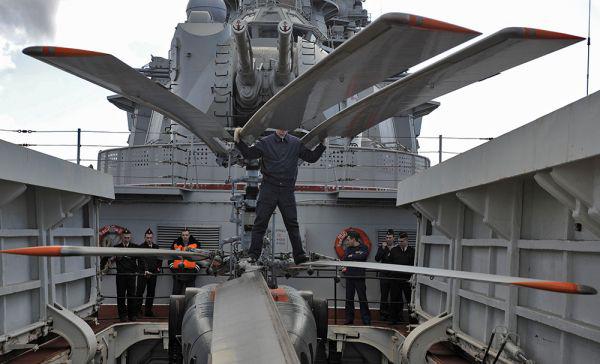
Neutron heart
The power plant, "Peter the Great" consists of two nuclear reactors on fast neutrons with a total capacity of 600 megawatts. Cruising is not limited. Cruiser showed the Russian flag in all four oceans, participated in the capture of the Somali pirates and escorted the caravan with the Syrian chemical weapons. In 2012, for their courage, dedication and professionalism shown by the personnel of the ship when the command assignments cruiser was awarded the Order of Nakhimov.
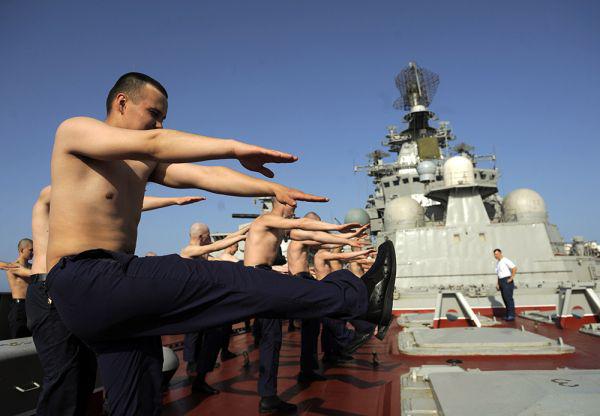
Source: www.rg.ru
The flagship of the Northern Fleet, the largest in the world aircraft carriers, heavy nuclear missile cruiser "Peter the Great" is really great - both in size and combat capabilities. His main weapon - cruise missiles "Granit" - are able to overcome any missile defense system and destroy the target, regardless of its size and the degree of protection. Missiles on board the cruiser 300, enough for many purposes. The main task of the ship is hunting for enemy aircraft carriers and their entourage.
Layered air defense cruiser reliably covers all of its existing and future assets of the air of defeat. No less serious and anti-submarine defense, consisting of helicopters and sonar, supersonic missiles, torpedoes and ingenious protivotorped, jet mortars and multiple rocket launchers. On the artillery duel in the modern sea battle speech does not go, so the main battery in the cruiser presented several towers with twin 130-mm guns. It is rather a tribute to the tradition - that of a cruiser without guns. "Granite" against "Aegis»
In 1983 came into operation the American missile cruiser "Ticonderoga". The ship was decorated with a banner "Beware, Admiral Gorshkov! "Aegis" in the sea! "Cruiser became the first American ship, equipped with combat information control system" Aegis "(Aegis). It brings together in a single network radar ships that are running, providing tracking of hundreds of surface, underwater and air targets, their automatic selection and guidance of weapons nearby ships to the most dangerous objects. Edakii Naval Internet.
In Greek mythology, Aegis shield called Zeus, made of the skins of magic goat Amalthea. In the middle of the shield was assigned the head of Medusa the Gorgon, gaze turns a man into stone. Now CICS "Aegis" equipped with 107 vehicles five countries. The heart of the system is a universal radar AN / SPY-1 - Four huge phased array antenna is mounted on its superstructures each armed "Aegis" ship. "Spy" is able to automatically search, classify and track targets, putting them anti-aircraft missiles. The use of a single multi-function radar allows us to simplify the collection and analysis of information, as well as eliminate the interference arising from the large number of radar.
However, in the universality of the radar "Aegis" lies their Achilles heel. One of the biggest challenges - how to effectively teach the radar to detect targets at large and small distances simultaneously. The creators hoped to "Interactive" system architecture: that the radar will detect distant targets and transmit information about them ship that close, and those are the targets to shoot down. But for this it is necessary to uniformly disperse the ships "Aegis" in the ocean, which in reality is impossible. In the context of the closeness of the battle order - order aircraft carrier, for example, - architecture is not working.
The main problem of "Aegis" - its radars operate in the decimeter range. Radio waves of such length is well reflected from the waves of the sea, so above the water noise and chaos system is blind to the ultra-low altitudes. Namely, they fly to the goal of the modern anti-ship cruise missiles - such as "Granite", the main weapon of "Peter the Great».
Vulnerability "Aegis" proved incident on 24 February 1991, in the Persian Gulf. In the US battleship "Missouri" grinds Iraqi forces 406-mm shells of the main fire, the shore launched two anti-ship missiles "Haiying 2" (a copy of the Soviet RCC "Termite" extended range). "Aegis" slept through the attack successfully. One rocket is 600 meters from the side of the British battleship destroyer shot down "Gloucester" - this was the first ever case of successful intercept anti-ship missile in combat using anti-aircraft missile system of short-range. The second "Missouri" led by himself, firing radar traps. According to another version, the missile fell into the water itself.

Fire sword
"Granite" at this chaff not up to snuff. When you create a set for the first time anti-ship sank with three channels targeting: mother ship, the missile itself and the external devices - they could be satellites, aircraft and other missiles. RCC "Granite" is equipped with an onboard computer trehprotsessornym (FDC). In his memory incorporated data on modern ship classes and types of orders, allowing the missile to determine that before her: the convoy, aircraft carrier or amphibious group - and attack the main goal in the group. This onboard computer analyzes used by the adversary electronic warfare, rebuilt from interference and issues commands to evade fire air defense systems.
Containers with the "granite" located under the main deck of "Peter the Great" with a slope of 60 degrees. Before starting the rocket container filled with seawater to hellfire solid booster not hurt silos. Through the accelerator the most noticeable part of the trajectory starting overcome a couple of seconds. Then turn on marching turbojet engine, the rocket rise to a height of 10-14 kilometers and "inspected". Finding purpose, "Granite" is reduced to 25 meters off the homing head and flies at half-two thousand kilometers per hour. GOS is activated just before the attack.
A group of attacking missiles. The main part of it invisible to radar sweeps over the water, one is flying high, diverting the enemy's air defense and coordinating action remaining. If her astray, takes place next leader. When an external target designator - aircraft or satellites - missiles and all can get to the goal secretly. The onboard computer incorporated several options for types of trajectories for each theater of operations and the type of target.
Arriving in the area of the attack, "Granite" include homing, for a split second partitioned between a target and hit them. To destroy surface ships used penetrating warhead with 750 kilograms of powerful explosives. Submarines stoked nuclear warhead capacity of 500 kilotons - such an explosion on the surface enough to destroy any submersible at a depth of up to a kilometer.

Reactive Shield
The air defense cruiser "Peter the Great" was organized at several levels. Long approaches gated complex "Fort", a naval version of the proven S-300 systems. Below deck are 12 launchers with a total of 96 rockets ammunition. Multifunction radar can simultaneously track 12 targets, firing six most dangerous. For the moment the system can make 20 starts.
If the rocket had managed to bypass the enemy: "Fort", it will meet the complex "Dagger", designed to reflect the massive flying air targets. His launchers and hidden under the deck. 16 plants, they drum, each containing eight missiles. "Dagger" affects low-flying targets at a height of 10 meters and at a distance of 45 kilometers. Radar complex accompanied by eight goals, while four of them firing. From the detection of the target before the start goes eight seconds. Antiaircraft missile warhead high explosive. By radio before it explodes purpose, forming a cloud of fire and metal. An enemy shell flies into him, his speed exacerbating the damage.
Antiaircraft artillery complex short-range "Dirk" protected cruiser of high-precision weapons, planes, helicopters and boats, each of the six units armed with two six-barreled 30-mm cannon total rate of 10,000 rounds per minute and eight rockets from the air defense system "Tunguska". They also explode in front of goal, using its speed to increase the damaging effect. The turret office is another 16 missiles. Management System "Dirk" consists of radar and television systems, interconnected system of artificial intelligence.
The cruiser has ten launchers for anti-missile-torpedoes "Waterfall", capable of hitting enemy submarines at distances up to 60 kilometers. The rocket dives into the water, then takes off and gives the target a miniature torpedo. She dives again and makes your wet work.
From torpedoes "Peter the Great" protected complex "Boa." He shoots several types of projectiles at different distances, forming one gulp tiered defensive line. The first missile cruiser going to meet decoys - they are trying to fool the seeker to a complete stop engine plavsnaryada. At the break of the first echelon of the torpedo at full speed rushes to drift minefield. Each dangling in the water column shell-torpedo-layer smells of ten meters and then explodes. If you have not helped and-layers, "BoA" deep shells fired to kill. On the bow and stern of the ship are reactive mortars "Smerch", ready to fill any target depth charges, approached the cruiser kilometer.

Neutron heart
The power plant, "Peter the Great" consists of two nuclear reactors on fast neutrons with a total capacity of 600 megawatts. Cruising is not limited. Cruiser showed the Russian flag in all four oceans, participated in the capture of the Somali pirates and escorted the caravan with the Syrian chemical weapons. In 2012, for their courage, dedication and professionalism shown by the personnel of the ship when the command assignments cruiser was awarded the Order of Nakhimov.

Source: www.rg.ru

